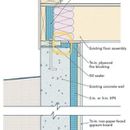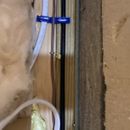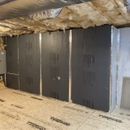Air Sealing and Insulating Around Sill Plate
I am working on my basement and need some advice on the sill plate area. I am in NH zone 6 and have a basement of about 1300 sqft, and I have moved the thermal boundary from fiberglass batts in the overhead joists and installed a layer of 3” reclaimed polyiso on the walls and 1.5” XPS on the slab. I am using leftover polyiso to air seal the rim joists and then cover with fiberglass. My issue is the 2-3” strip on the top of the concrete wall and the sill plate. I had planned to also use strips of the polyiso in this area but it is proving very difficult to get good cuts and seal against the sill plate (probably should have done before putting the polyiso up). Also my Romex and coax is stapled a lot to the sill plate (see pictures). I know some counties require this area to be left open for termite inspections, what are the recommendations in those cases? How important it is to get this area well sealed? Is there a big risk of condensation, if I can’t air seal it would some batt insulation work and if so which type? I know many would suggest two-part spray foam but would rather stay away from that. Thanks. I have read enough on here to know I don’t know enough.
GBA Detail Library
A collection of one thousand construction details organized by climate and house part












Replies
Hi Charlie,
I will give your post a bump. Note that the fiberglass is air permeable and will not provide air sealing. I think caulk would be what you want to use here, but let's see if anyone can add more advice.
You also might want to read Martin's article on air sealing basements. (https://www.finehomebuilding.com/2012/01/19/air-sealing-a-basement)
Charlie, I agree with Steve--air-sealing that location is probably good enough. Concrete is porous so any condensation will either be absorbed or will dry to the interior.
Thanks Mike. So a bead of caulk or foam on the sill plate joint to the concrete should be good. Is it worth stuffing some rockwool or other over it?
Charlie, for air-sealing I like to use a low-VOC sealant that will remain flexible, such as Pro Clima Contega HF. But other products will also work. Adding mineral wool will increase the risk of moisture accumulation so I would probably skip it, but if your basement is dry it might be ok--hard to say either way. Maybe put it in and check behind it occasionally.
Why the concern with mineral wool holding moisture? I thought it was vapor open and hydrophobic?
I think he's referring to lowering the temperature of the plate/concrete while not providing air or vapor protection.
I wondered this is well. It is common to see videos and articles/diagrams detailing a piece of 1.5" foam adhered to the top of the concrete wall flush with the sill plate, typically overlapping with the wall foam foamed in place. So essentially covering all the concrete.
However, I have never seen any detail about what to do, if anything more then air sealing, with the face of the sill plate that is still exposed after adhering foam to the Rim joist (the exposed part facing towards the subfloor, as in the OP's diagram above). If this area is accessible (i.e. no wires), is it recommended to put another strip of foam overtop, sealed in place, or leave it exposed? If left exposed, with a typical Roxul batt installed after the Rim joist foam, would this not lead to potential condensation issues on the top of the sill plate? Curious as to best practices here, as it is tough to find any details that cover this area with a cut n cobble approach.
I just posted a question about this exact thing so am bumping in hopes for a few more responses from the community experts.